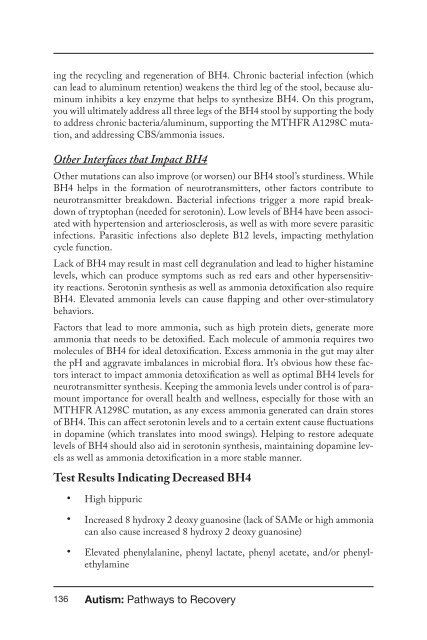3dT4E4Rnm
3dT4E4Rnm
3dT4E4Rnm
You also want an ePaper? Increase the reach of your titles
YUMPU automatically turns print PDFs into web optimized ePapers that Google loves.
ing the recycling and regeneration of BH4. Chronic bacterial infection (which<br />
can lead to aluminum retention) weakens the third leg of the stool, because aluminum<br />
inhibits a key enzyme that helps to synthesize BH4. On this program,<br />
you will ultimately address all three legs of the BH4 stool by supporting the body<br />
to address chronic bacteria/aluminum, supporting the MTHFR A1298C mutation,<br />
and addressing CBS/ammonia issues.<br />
Other Interfaces that Impact BH4<br />
Other mutations can also improve (or worsen) our BH4 stool’s sturdiness. While<br />
BH4 helps in the formation of neurotransmitters, other factors contribute to<br />
neurotransmitter breakdown. Bacterial infections trigger a more rapid breakdown<br />
of tryptophan (needed for serotonin). Low levels of BH4 have been associated<br />
with hypertension and arteriosclerosis, as well as with more severe parasitic<br />
infections. Parasitic infections also deplete B12 levels, impacting methylation<br />
cycle function.<br />
Lack of BH4 may result in mast cell degranulation and lead to higher histamine<br />
levels, which can produce symptoms such as red ears and other hypersensitivity<br />
reactions. Serotonin synthesis as well as ammonia detoxification also require<br />
BH4. Elevated ammonia levels can cause flapping and other over-stimulatory<br />
behaviors.<br />
Factors that lead to more ammonia, such as high protein diets, generate more<br />
ammonia that needs to be detoxified. Each molecule of ammonia requires two<br />
molecules of BH4 for ideal detoxification. Excess ammonia in the gut may alter<br />
the pH and aggravate imbalances in microbial flora. It’s obvious how these factors<br />
interact to impact ammonia detoxification as well as optimal BH4 levels for<br />
neurotransmitter synthesis. Keeping the ammonia levels under control is of paramount<br />
importance for overall health and wellness, especially for those with an<br />
MTHFR A1298C mutation, as any excess ammonia generated can drain stores<br />
of BH4. This can affect serotonin levels and to a certain extent cause fluctuations<br />
in dopamine (which translates into mood swings). Helping to restore adequate<br />
levels of BH4 should also aid in serotonin synthesis, maintaining dopamine levels<br />
as well as ammonia detoxification in a more stable manner.<br />
Test Results Indicating Decreased BH4<br />
• High hippuric<br />
• Increased 8 hydroxy 2 deoxy guanosine (lack of SAMe or high ammonia<br />
can also cause increased 8 hydroxy 2 deoxy guanosine)<br />
• Elevated phenylalanine, phenyl lactate, phenyl acetate, and/or phenylethylamine<br />
136 Autism: Pathways to Recovery


